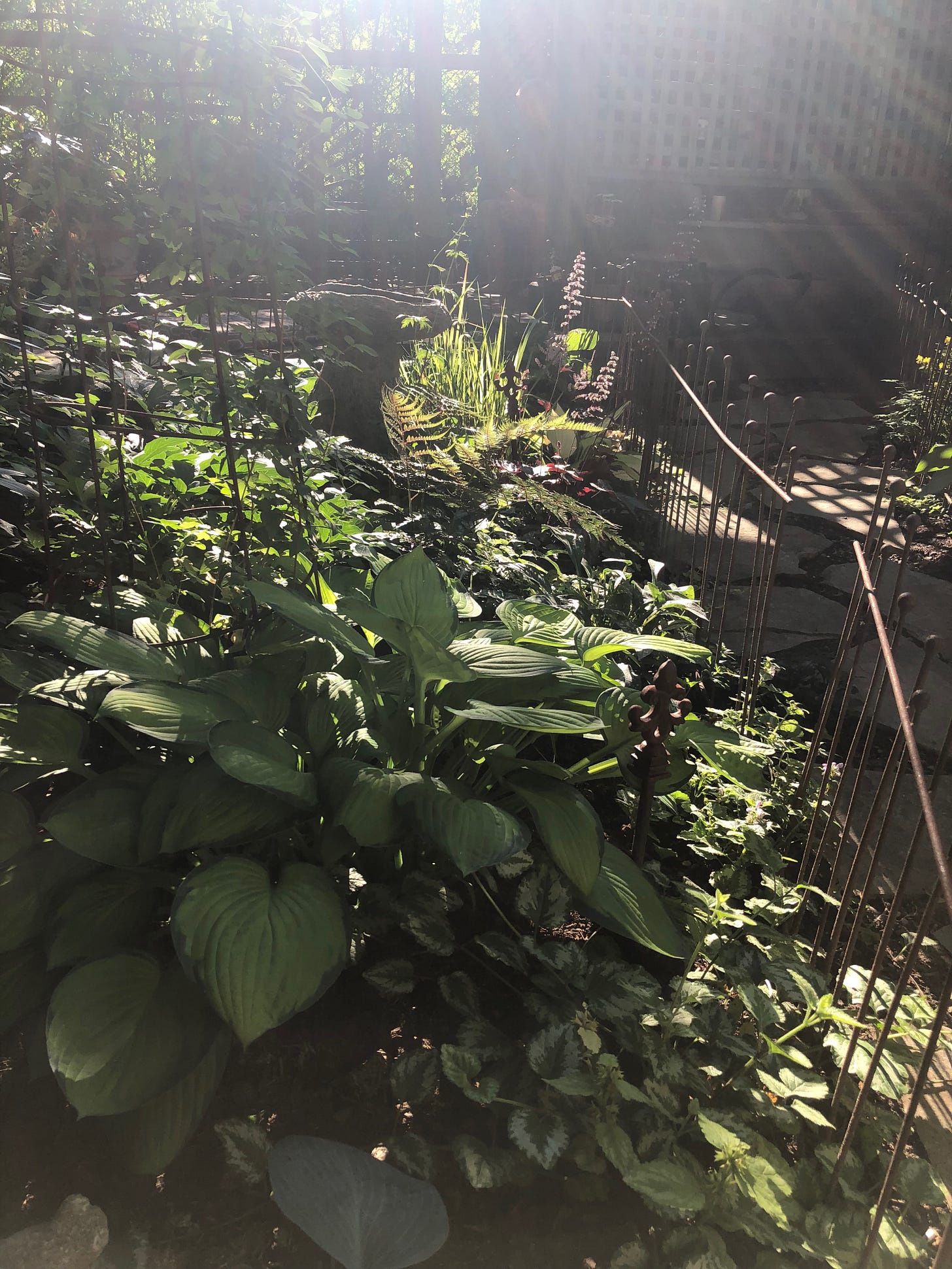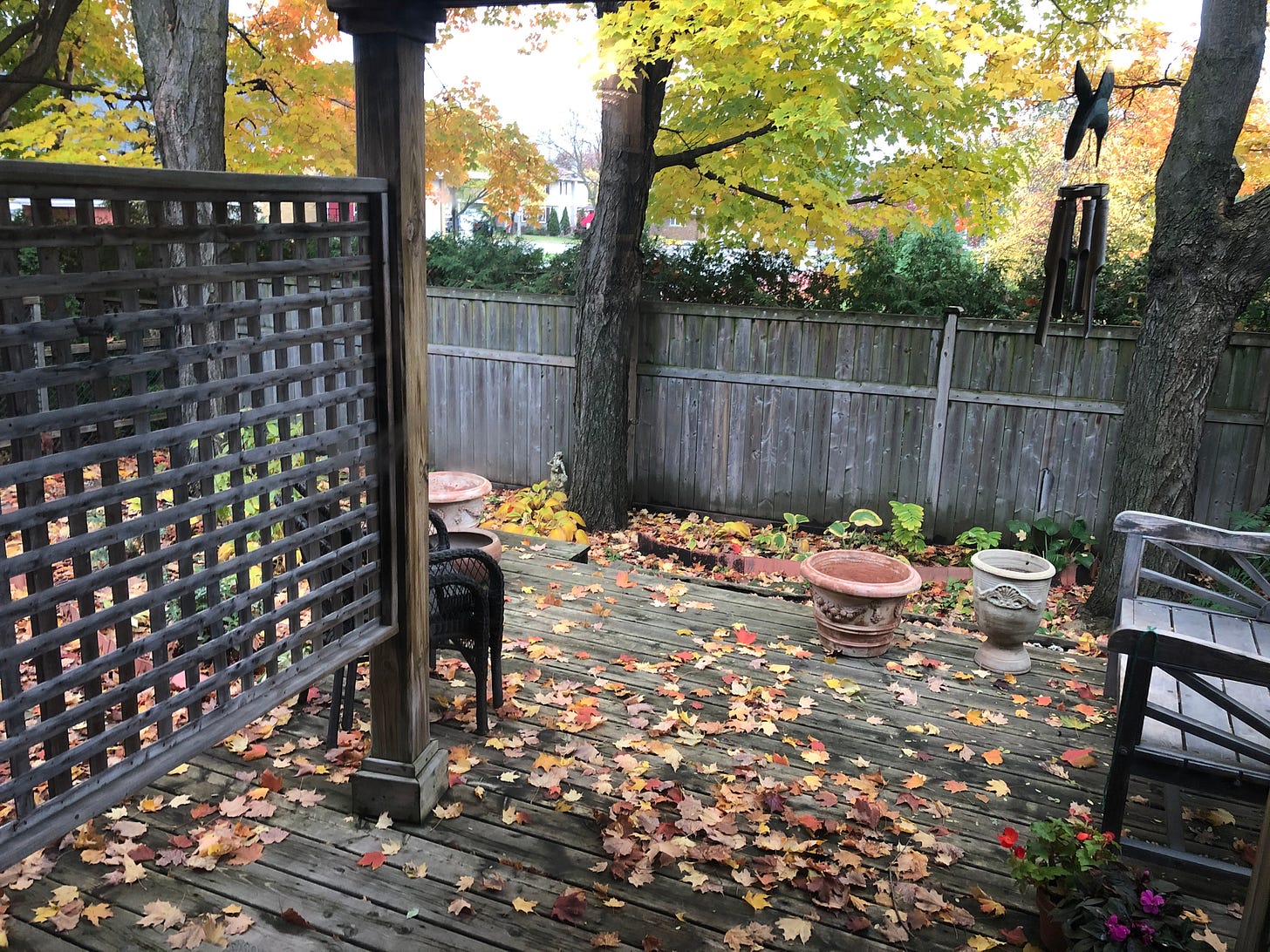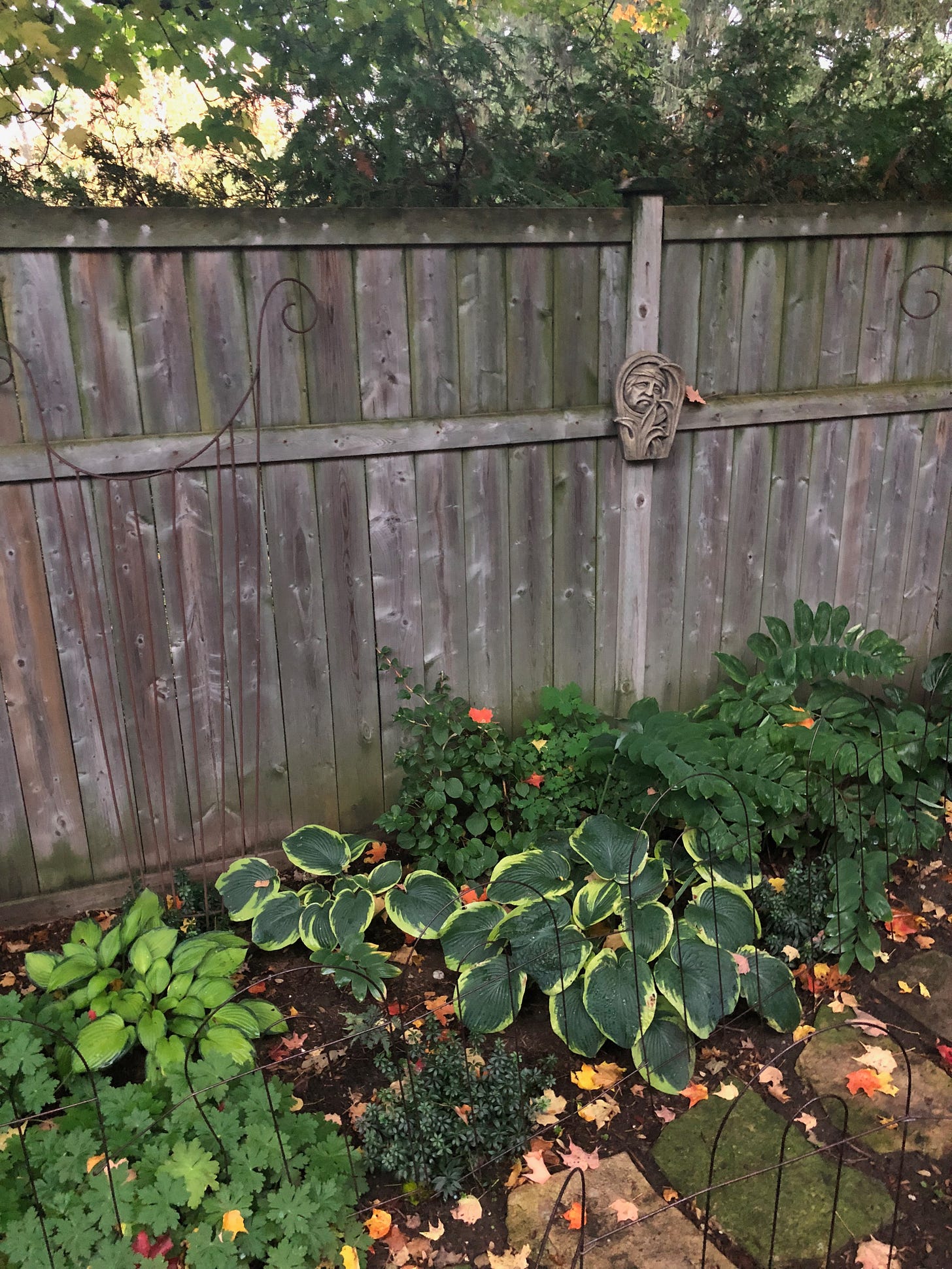My tiny new garden is south-facing but overhung by a row of three mature sugar maples. This makes for wonderful colour when the leaves turn in the fall, but for the rest of the growing season, finding plants to survive under the shade of its branches and the competition of its roots is challenging.
And yes, we must speak of the fencing. Truth is, if you have a new garden and a dog who is new to the garden, it’s important to identify pathways. Otherwise, a dog will pee where a dog will pee, and if that’s the case, then goodbye plants. Scoutie doesn’t seem too perturbed by this phenomenon, although there have been times when she’s crashed through a section of fencing chasing a squirrel. The good news is that this fencing is pretty forgiving, so there’s no chance of any injury. An added bonus is that it gives the squirrel more time to skedaddle.
Enter Geranium macrorrhizum, also known as Big root geranium. This perennial is a must-have for shade, especially shade that is challenging in terms of lack of moisture and root competition. I planted several 2-gallon pots of it, about 18” apart, last spring and early summer in two rows along the rear fence and between the mature maples in soil that was both dry and densely rooted. I ended up crumbling away much of the loose soil in the pots as the holes I dug were relatively small, but by watering the holes generously before backfilling them, the geranium roots were happy. By the summer of 2022, they will likely have spread to cover most of that empty ground between them. Even with the relatively dry soil in that area (both from the thirsty maple roots and from the branches that overhang and prevent much rain from getting through), the leaves of these geraniums were largely turgid all summer long. Yes, in severe heat I put the sprinkler on them, especially since they were new plants, but they weathered the conditions bravely. If I’d had my druthers, I would have chosen the white cultivar called ‘Spessart’, but I was keen to fill in this space quickly and there were none to be found when I went to my favourite garden centre.

So, I ended up going with the more common brash pink form called ‘Bevan’s Variety’. I won’t fret about this, even though much of the other colours in this garden are better suited to softer hues…

When I first moved in, the only perennials in this lower part of the garden were hostas as well as some plain and variegated Solomon’s Seal. This photo (below) was taken upon move-in during the fall, October to be precise. The full breadth of the plantings were not yet visible, but the yucky plastic clay-coloured edging was (you can see some of it a few feet in front of the fence) and, of course, it was the first thing I tore up!
The hostas included a couple of ‘Frances Williams’, which is a large slug-resistant variety with beautiful blue leaves edged in chartreuse; they were next to each other and one was more mature than the other. Honestly, they looked so happy I didn’t dare move them, so against my instincts, I let them be. I may move the smaller one in the rear next spring and place it in another spot. Perhaps I’ll put in something to contrast the foliage, likely a Lady fern, as this perennial is also a stellar performer in dry shade.
The very small leafed plant in front is sweet woodruff (Galium odoratum), which is a marvellous groundcover for dry shade and sports tiny white scented flowers in the spring. To the right you can see the Solomon’s seal that were already there (I also left these be) but also against the fence, in dead centre, is a climbing hydrangea that I put in to cover the vast expanse of cedar fence over time. I did really have to pay attention to this hydrangea over the summer as it needed a lot of extra water to stay happy. Hopefully I’ll see some real growth from it soon and it will begin to slowly cover that fence with green in the summer and stems that will catch the snow and give dimension during the winter months.
I dressed the entire garden in mushroom compost, both as a soil additive and a mulch; sadly, this was after I had purchased many bags of “worm castings” which was a miserable investment — it dried up like dust and did nothing for the soil structure. And the existing flagstones, some thick, some thinner, were rearranged to form a more pleasing path. It’s the kind of path that requires a regular sweeping to keep it tidy - I will admit to doing this maybe once every couple of days - does that make me obsessive? Nah. Just tidy.
The Japanese painted fern (to the left, behind the stone birdbath), is a variety of Lady fern, known botanically as Athyrium niponicum ‘Pictum’. The literature indicates that it requires wet to moist soil in order to be happy; I’m quite certain it doesn’t get that here, although it is far enough away from the maple roots that it is not compromised by them. The companion fern at the front centre is known as Autumn fern (Dryopteris erythrosora), and has beautiful coppery fronds when they first appear, turning a lush green as they mature. Both of these ferns are perfect complements to the broad, pleated leaves of hosta, in this planting I’ve chosen my favourites: ‘June’ in the foreground and ‘Paul’s Glory’ in the rear.
One plant I’ve had zero success planting in this dry shade garden has been Astilbe. Granted, there are two, I believe, that predated me here and they both have been soldiering on - likely due to an established root system that allows them to draw on moisture from below. Astilbes are notorious for their wilful discontent when things don’t go their way - that is, they shrivel up and become defiantly crispy when the soil is not kept evenly moist. This is, in my books, totally unsatisfactory and a good reason to never plant one again — unless, of course, you’re graced with a stream in your backyard and you can then place them on it’s edge, along with maybe some beautiful candelabra primrose. But, a stream I do not have.
But back to what does work well here. Yellow Archangel is a vigorous trailing groundcover that I’d never really considered before now, but have found it growing very happily in this garden. This is great as it meanders with gusto between larger, more striking plants in the main beds, providing an interesting carpet through which they grow. Known by its Latin name, Lamiastrum galeobdolon, this plant has an upright flowering stem that appears in June, with yellow blooms having the structure like those of mint, but the real attraction is its variegated foliage, which doesn’t seem to interest pests, and that includes rabbits, my nemesis in this garden.

The edge of this upper garden uses bugleweed as a carpet, namely the varieties ‘Black Scallop’ and ‘Burgundy Glow’, the former with dark purple foliage and the latter with tricolour; both have upright blue/purple flowers in the late spring or early summer. Ajuga reptans or bugleweed will grow practically anywhere so no worries keeping it happy in this challenging site.
This garden is still very much a work in progress, but I’ll be very happy to report back about what’s working, what’s not this summer. I have limited space to plant new plants, but I’m sure I’ll eject what’s not working with a certain amount of glee — more room for new!





